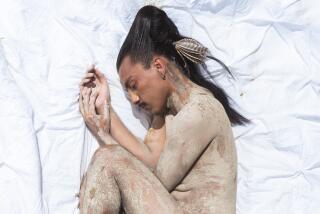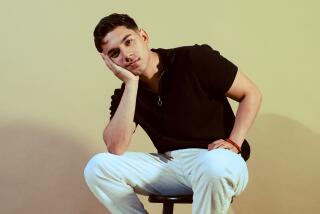Latino rapper lets the ethnic insults fly
Pedro Herrera III arrived hours late to his performance at El Parral supper club in South Gate on Wednesday night, meeting eager fans backstage past midnight and not taking the stage until well into early Thursday.
But his audience didn’t seem to mind the wait. When you’re both an aspiring hip-hop mogul and a self-satirizing Mexican caricature, fashionable tardiness is the smoothest of entrances.
“I’m not from here,” Herrera told the crowd when he finally began his set, “but I feel like I’m at home here because I’m from the hood ....Por favor, balieeeeeve it.”
The room roared in approval.
Herrera, who goes by the name Chingo Bling -- a twist on a Spanish obscenity -- is from predominantly Mexican American southeast Houston and is fast becoming one of the most recognizable faces in the still maturing Latino hip-hop scene.
But as his South Gate appearance this week showed, his fame is not rising necessarily because of his skills as an MC. Rather, he is generating buzz because an instinctual response upon first seeing him in action is often an Ali G-like, “Is this guy for real?”
When inhabiting his Chingo Bling persona, the rapper wears a Paul Wall-designed hip-hop “grille” on his teeth (made of diamonds in the colors of the Mexican flag), ostrich-skin boots (customized with Nike swooshes), aviator sunglasses and an oversized black Stetson.
He raps about taco shops, tamales, the U.S. Border Patrol and his trademark rooster Cleto, and he calls himself the “ghetto vaquero, the tamale kingpin, the Versace mariachi, the ran-cholo.”
The wordplay and slang slaughter only start there.
In his track “What Did He Said (Remix),” the chorus goes: “I ride with rancheros / And roll with cold pistoleros / And hang with ghetto vaqueros / Because I’m all about pesos.”
For Herrera, all “v”s are replaced with “b”s, making his videos “bideos” and his DVDs “DBDs.” Words that normally begin with “s” get an automatic “e” as a prefix, as in “estupid” and “especial.”
The results mock many recently arrived Mexican immigrants’ mispronunciation of English.
“In two words,” he said, explaining his name during a lunch interview Wednesday at downtown L.A.’s Clifton’s Cafeteria, “it embodies flyness, like style, and Mexican culture.”
Mexican American border culture, to be exact.
Herrera, who is in his mid 20s, is a hip-hop-style embodiment of the working-class Mexican cowboys who live in Texas, New Mexico, Arizona and California.
But he complicates the stereotypes by amplifying them, casting a satirical eye on his own upbringing as a child of Spanish-dominant Mexican immigrant parents from northern Tamaulipas state.
Josh D. Kun, Los Angeles music writer and associate professor of English at UC Riverside, calls Chingo Bling “a kind of hip-hop court jester, in a Latino world.”
Adds Kun, “It just reminds me of, on the one hand, 1920s ethnic dialect humor, misunderstandings, mispronouncing words on purpose. The Jews and the Irish comics did it.”
But, says Kun, the performer has also “taken that satirical self-critical ethnic comic pose that Cheech and Chong polished off, and he’s retooling it for the hip-hop set.”
Beneath the bawdy, comical exterior, Herrera hides a serious, goal-oriented businessman, who earned a degree in marketing from Trinity University in San Antonio. He sees his Chingo Bling persona as a brand name perfectly suited to appear on the bobbleheads and coloring books he produces, as well as in videos, including a raunchy, “Girls Gone Wild”-style series called “Manosas” that his production company sells.
Herrera also makes appearances on Southern California hip-hop radio station Power 106 (105.9 FM) and the bilingual mun2 cable television. He’s been on MTV2 and MTV News, and is planning more films and a possible fast-food restaurant chain.
The rapper is clear about his desire to rise to the upper echelon of multimedia hip-hop moguls he admires, such as Russell Simmons and Master P -- “guys who make good business moves and have longevity, the kind of stuff that I care about,” he said.
That drive has worked for him so far. Herrera started off early in the booming underground hip-hop scene in Houston in the late 1990s. He began selling his homemade mix tapes when he was still a teenager.
He would hide his Chingo Bling identity from customers and act like an everyday salesman, using the anonymity to ask Chingo Bling fans why they liked him.
Before long, fans were spotting Chingo Bling on street corners and mobbing him at large music events. A production company, Big Chile Enterprises, naturally followed.
“We’re all young Mexicans from the hood who didn’t have Hollywood next door, who didn’t have Universal Records down the street,” he said. “[Now] we’re in a little spot, we’re outgrowing it, and the beautiful thing is we’re in control of our own destiny.”
At El Parral, a Mexican club on speedy and heavily policed Firestone Boulevard, the crowd packed the dance floor for hours while waiting for the show.
They danced to a mix of hip-hop, cumbias and reggaeton. After arriving, the rapper posed for fans’ cellphone cameras, in a long rear hallway, and he was in no apparent rush to make it to the stage.
South Los Angeles resident Keller Navarrete, 19, wore a straight-billed, side-cocked baseball cap and a wide smile after posing for a photo with Chingo Bling.
“He’s close to us, he represents our L.A.,” Navarrete said. “He talks about tamales. That’s what we eat for Christmas! ... He’s someone from the hood, making it.”
More to Read
The biggest entertainment stories
Get our big stories about Hollywood, film, television, music, arts, culture and more right in your inbox as soon as they publish.
You may occasionally receive promotional content from the Los Angeles Times.










